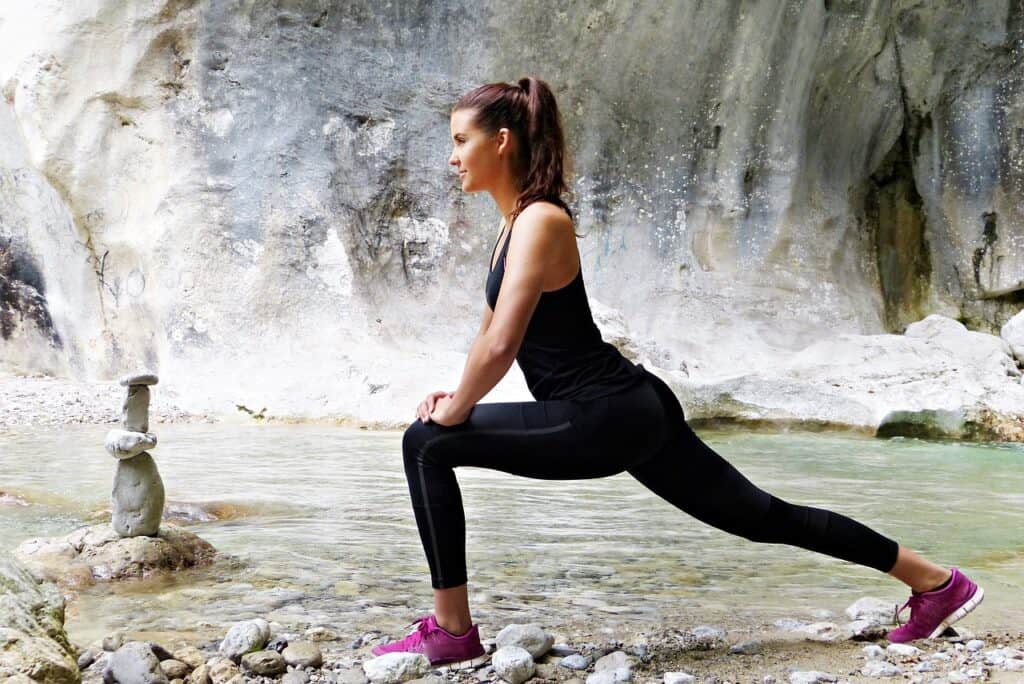Are you a runner looking to optimize your performance and reduce your risk of injury? Discover the 21 best dynamic stretches specifically designed for runners. These dynamic stretches, incorporated into your warm-up routine, will help improve flexibility, speed, and overall running performance. Say goodbye to stagnant stretching and unlock your running potential with these innovative exercises.
Key Takeaways:
- Dynamic stretches enhance flexibility and speed for runners.
- Integrating dynamic stretches into your warm-up routine can optimize performance.
- Dynamic stretches reduce the risk of injury during running.
- These exercises are designed to target specific muscle groups used in running.
- By incorporating these 21 best dynamic stretches, runners can perform at their best.
Benefits of Dynamic Stretching
Dynamic stretching offers numerous benefits to runners. In addition to preparing the body for physical activity, dynamic stretches can improve running performance, increase flexibility, and reduce the risk of injury.
One of the key advantages of dynamic stretching is its ability to enhance running performance. By incorporating dynamic stretches into your warm-up routine, you can activate the muscles used during running and improve their efficiency. This can result in increased speed, agility, and overall performance on the track or road.
Another important benefit is the impact on flexibility. Unlike static stretching, which involves holding a stretch for an extended period, dynamic stretching involves moving through a full range of motion. This helps to lengthen and loosen the muscles, allowing for greater flexibility and a wider range of movement. Increased flexibility can enhance running efficiency and reduce muscle imbalances, contributing to better overall performance.
Furthermore, dynamic stretching can play a crucial role in injury prevention. By engaging the muscles in a dynamic and controlled manner before running, you can activate the body’s natural protective mechanisms. This can help to improve muscle elasticity, reduce muscle resistance, and decrease the likelihood of strains, sprains, and other running-related injuries.
“Dynamic stretching prepares the body for the demands of running, enhancing performance, promoting flexibility, and minimizing the risk of injury.”
In summary, dynamic stretching is a valuable component of a runner’s warm-up routine. Its benefits include improved running performance, increased flexibility, and a reduced risk of injury. By incorporating dynamic stretches into your pre-run routine, you can optimize your performance and enjoy a safer and more effective running experience.
Beginner Dynamic Stretches for Runners
For beginners, incorporating gentle dynamic stretches into their warm-up routine is essential. These stretches specifically target the major muscle groups used in running, preparing the body for optimal performance. Below, we have outlined seven beginner-friendly dynamic stretches that are easy to perform.
Leg Swings
Stand tall with your feet hip-width apart, holding onto a stable object for support, if necessary. Swing one leg forward and backward in a controlled manner, focusing on keeping the movement fluid. Repeat 10-15 times per leg.
Knee Hugs
Stand tall with your feet hip-width apart. Lift one knee toward your chest and hug it with both arms. Hold this position for a few seconds, then release and repeat with the other leg. Perform 10-15 reps per leg.
Lunges
Take a step forward with your right foot and lower your body into a lunge position by bending your right knee to a 90-degree angle. Ensure that your front knee is directly above your ankle. Push off your right foot and return to the starting position. Repeat on the other side. Complete 10-15 reps per leg.
Toe Touches
Stand tall with your feet hip-width apart. Slowly bend forward from the hips, reaching your hands towards your toes. If you can’t touch your toes, aim for your shins or ankles. Hold this position for a few seconds, then return to an upright position. Perform 10-15 reps.
Heel Walks
Begin by standing tall with your feet hip-width apart. Lift your toes off the ground and walk forward on your heels, maintaining a straight posture. Take small steps, ensuring that your heels are the only parts of your feet making contact with the ground. Walk for approximately 30 seconds.
Arm Circles
Stand tall with your feet hip-width apart. Extend your arms out to the sides parallel to the ground. Start making circles with your arms, gradually increasing the size of the circles. After a few seconds, reverse the direction. Repeat this exercise for 30 seconds.
Butt Kicks
Stand tall with your feet hip-width apart. Begin jogging in place while kicking your heels back towards your glutes. Aim to touch your buttocks with your heels with each kick. Continue jogging and kicking for 30-60 seconds.
By incorporating these dynamic stretches into your warm-up routine, you can improve flexibility, enhance muscle activation, and reduce the risk of injuries while running. Remember to listen to your body and never push yourself beyond your limits.
Intermediate Dynamic Stretches for Runners
As runners progress and become more comfortable with dynamic stretching, they can incorporate slightly more challenging stretches to further improve flexibility. This section will present seven intermediate-level dynamic stretches that target specific muscle groups and promote greater range of motion.
Inchworm
The Inchworm stretch is an excellent exercise for targeting the hamstrings, shoulders, and core muscles. Start in a push-up position and walk your feet towards your hands, keeping your legs as straight as possible. Once you reach a comfortable point, walk your hands forward again and repeat the movement.
Walking Lunges with Twist
This dynamic stretch is ideal for enhancing flexibility in the hips, quads, and obliques. Take a step forward into a lunge position and twist your torso towards the side of the front leg. Return to the starting position and repeat on the other side, alternating between lunges and twists.
Toy Soldier
The Toy Soldier stretch targets the hamstrings and quadriceps while improving balance. Stand tall and extend one leg straight in front of you, keeping it as straight as possible, while reaching for your toes with the opposite hand. Repeat on the other side, walking forward with each step.
Leg Swings
Leg swings are a dynamic stretch that targets the hip flexors and improves range of motion. Stand next to a wall or support and swing one leg forward and backward in a controlled manner. Repeat on both legs for a total of 10 swings on each side.
Spiderman Stretch
The Spiderman stretch is a dynamic movement that stretches the hip flexors, hamstrings, and groin. Start in a push-up position, bring one foot forward towards the same side hand, and drop the opposite elbow down for a deep stretch. Return to the starting position and repeat on the other side.
Scorpion
The Scorpion stretch targets the hip flexors, lower back, and shoulders. Lie face-down with arms spread out to the sides. Lift one leg off the ground and swing it across your body, attempting to touch the opposite hand. Return to the starting position and repeat on the other side.
Sumo Squat with Reach
The Sumo Squat with Reach is a dynamic stretch that targets the inner thighs, hips, and upper back. Stand with your feet wider than shoulder-width apart, toes turned out. Squat down while reaching one hand towards the ground, then reach the same hand towards the ceiling as you stand back up. Repeat on the other side.
By incorporating these intermediate dynamic stretches into your warm-up routine, you can continue to improve flexibility and prepare your body for more advanced exercises. Practice these stretches regularly and listen to your body to find the right level of challenge and progress at your own pace.
Advanced Dynamic Stretches for Runners
For advanced runners who are determined to take their speed and performance to the next level, incorporating advanced dynamic stretches into their routine is crucial. These dynamic stretches are designed to challenge the body, requiring greater strength and flexibility to perform.
By regularly practicing these advanced dynamic stretches, experienced runners can push their limits, optimize their running speed, and improve overall flexibility.
1. Multi-Directional Lunges
The multi-directional lunges target the hips, thighs, and glutes while also improving stability. Perform forward, side, and diagonal lunges to engage different muscle groups and enhance the range of motion.
2. High Knee Skips
High knee skips are a powerful exercise to activate the hip flexors, increase stride length, and boost running speed. While skipping, focus on lifting the knees as high as possible, maintaining an upright posture, and propelling forward with explosive force.
3. Power Skipping
Power skipping is an advanced dynamic stretch that targets the calves, quads, glutes, and hamstrings. This exercise involves skipping with maximum force and height, emphasizing power and explosiveness in each skip.
4. Straight Leg Bounds
Straight leg bounds are ideal for improving running speed and enhancing the stride length and power of each step. Perform bounds by forcefully pushing off the ground with one leg and propelling the body forward in a long, bounding motion.
5. Plyometric Jump Squats
Plyometric jump squats are an excellent exercise to improve explosive power in the lower body. Begin by performing a deep squat, then explosively jump as high as possible, and land softly back into the squat position, repeating the movement.
6. Inchworms with Push-Ups
Inchworms with push-ups are a challenging exercise that targets the upper body, core, and hamstrings. Start by standing, then walk your hands forward into a high plank position, perform a push-up, and then walk your feet back to your hands to complete the movement.
7. Single-Leg Romanian Deadlifts
Single-leg Romanian deadlifts are an advanced exercise that targets the hamstrings, glutes, and core while improving balance and stability. Perform this exercise by hinging at the hips, extending one leg backward, and lowering the upper body while keeping the back straight.
Remember, advanced dynamic stretches should only be performed after proper warm-up and with caution. It’s essential to listen to your body and not push beyond your limits to avoid injuries.
| Dynamic Stretch | Primary Muscles Targeted |
|---|---|
| Multi-Directional Lunges | Hips, thighs, glutes |
| High Knee Skips | Hip flexors, quadriceps |
| Power Skipping | Calves, quadriceps, glutes |
| Straight Leg Bounds | Quadriceps, glutes, hamstrings |
| Plyometric Jump Squats | Quadriceps, glutes, calves |
| Inchworms with Push-Ups | Upper body, core, hamstrings |
| Single-Leg Romanian Deadlifts | Hamstrings, glutes, core |
For a deeper look into dynamic and static stretches check out the article titled: DYNAMIC VS. STATIC STRETCHING: BENEFITS COMPARED

Conclusion
In conclusion, incorporating dynamic stretches into your warm-up routine as a runner is essential for optimizing performance and reducing the risk of injury. By engaging in these pre-run exercises, you can enhance flexibility, promote greater range of motion, and prepare your body for the demands of running.
Throughout this article, we have introduced 21 diverse dynamic stretches that are tailored specifically for runners. These stretches target various muscle groups and address the unique needs of beginner, intermediate, and advanced runners.
Remember, the key to reaping the benefits of dynamic stretching is consistency. By including these best dynamic stretches in your warm-up routine, you can ensure that your body is properly primed for your runs, enabling you to achieve your personal best and stay injury-free.

